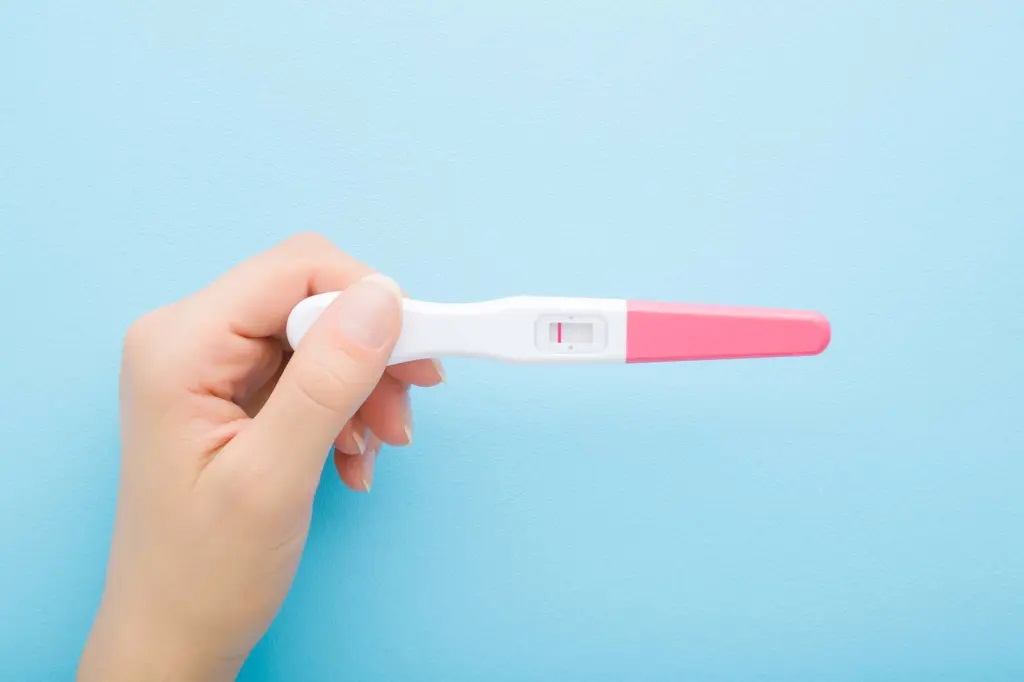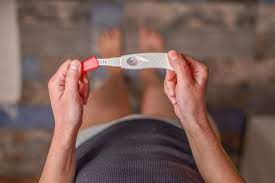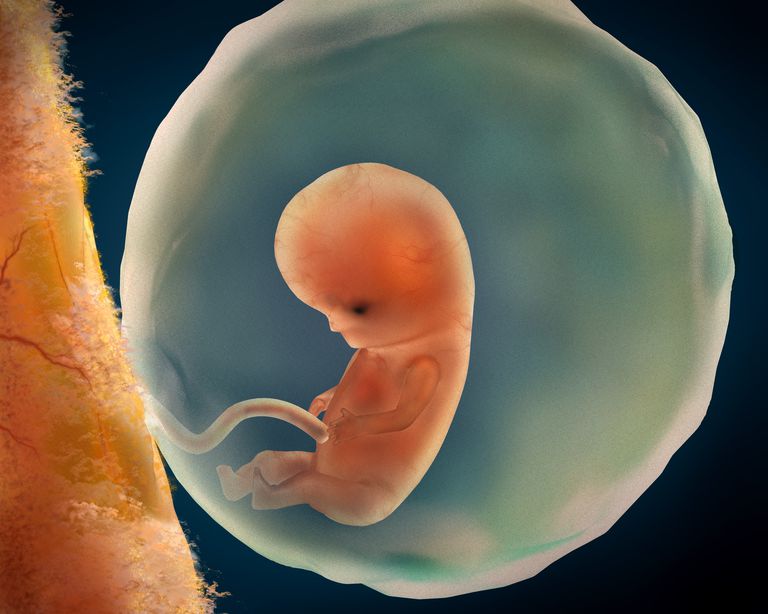"What are my hopes and plans for the future, and how could abortion, adoption or parenting affect them?"
"What 2 or 3 things matter most to me in my life now, and how could my decision affect these?"
"What do I hope to achieve over the next 5 to 10 years, and how might my decision affect this?"
"How would I feel if I: become a parent, pursue adoption, or end the pregnancy?"
""How would the people closest to me react if I: become a parent, pursue adoption, or end the pregnancy?"
If you think you may be pregnant, the first thing to do is to find out whether you really are.
A pregnancy test is the most reliable way to confirm if you are pregnant. Many tests give an accurate result from the first day your period was due. If your periods are not regular, take the test 3 weeks after unprotected sex.
You can buy reliable home pregnancy tests from high street chemists and most supermarkets. Many pharmacists also offer a pregnancy testing service. Alternatively, Your GP, contraception and sexual health service or family planning clinic may be able to offer you a free test.
Pregnancy Tests
How do pregnancy tests work?
Pregnancy tests are an easy and accurate way to find out if you’re pregnant — you just pee on a stick. They’re inexpensive and available at most drug and grocery stores.
How accurate are pregnancy tests?
Pregnancy tests are super accurate when you use them correctly. The pregnancy tests you get at the drugstore work 99 out of 100 times. They’re just as accurate as a urine pregnancy test that you’d get at a doctor’s office.
Pregnancy tests work by checking your urine (pee) for a hormone called human chorionic gonadotropin (HCG). Your body only makes this hormone if you’re pregnant. HCG is released when a fertilized egg attaches to the lining of your uterus — when pregnancy begins. If your pregnancy test results are positive, it means you’re pregnant. If they’re negative, it means you’re not pregnant.
Pregnancy tests are most accurate when you take them after you’ve already missed your period.
A pregnancy test will be less accurate if it’s expired or if you don’t use it the right way. So always check the expiration date on the package, and carefully read the directions that come with your pregnancy test.

How soon can I take a pregnancy test?
You can take a pregnancy test anytime after your period is late — that’s when they work the best. It’s a good idea to take a pregnancy test as soon as possible if you miss your period or think you might be pregnant.
The earlier you know you’re pregnant, the sooner you can start thinking about your options and get whatever care you need to stay healthy.
Many pregnancy tests say they work a few days before a missed period, but the results are usually less accurate then. Read the label on your pregnancy test to find out when to take a pregnancy test and how accurate it’ll be.
Sometimes a pregnancy test is able to find pregnancy hormones in your urine as early as 10 days after unprotected sex. But these results aren’t super reliable, and you may get a false positive or false negative test result.
If your periods are very irregular, or you don’t get periods at all for one reason or another, your best bet for accurate results is to take a pregnancy test 3 weeks after sex.
Where can I get a pregnancy test?
You can buy a pregnancy test at your local pharmacy, drugstore, grocery store, and some convenience or dollar stores. Pregnancy tests are usually inexpensive — they can cost as little as a dollar. Sometimes you can get a free pregnancy test at certain health centres.

Every day, numerous people turn to the internet for information on how to induce or force a miscarriage. In the toughest of circumstances, it can be tempting to want to take matters into your own hands. However, doing so is incredibly dangerous for your health and is never recommended unless supervised by a medical professional.
Ending an Unwanted Pregnancy
If you are researching how to induce a miscarriage because you have an unwanted pregnancy, please do not risk your health by attempting unsafe methods of ending your pregnancy. Research your options for handling an unplanned pregnancy and find someone who can help you handle the situation safely. There are numerous resources out there, as well as support resources for those without friends and family who can help. If you have decided to end your pregnancy, rather than search for ways to end your pregnancy yourself, look for local women’s clinics or a nearby Planned Parenthood. If you state has placed strict restrictions on abortion, you may have to travel beyond state lines for care.
Inducing a miscarriage on your own is never a good idea. By trying to induce your own miscarriage, you are not only risking the life of the fetus but your own life as well. Taking foreign pills or overdosing on supplements is dangerous to your health and can have both long- and short-term risks. Procedures performed by those other than a licensed medical professional can also jeopardize your future reproductive health.
There is no safe and reliable way to induce a miscarriage without the involvement of a doctor. In dire situations, it may be tempting to follow any “advice” you may see floating around the Internet. However, these seemingly “helpful tips,” are not recommended by medical professionals.
Speeding Up Miscarriage to Avoid Dilation and Curettage (D&C)
If you have been diagnosed with a missed miscarriage or blighted ovum, you may be researching inducing miscarriage in order to avoid a dilation and curettage (D&C), a procedure which removes tissue from your uterus. Unfortunately, there is no safe way to speed up a miscarriage on your own. As mentioned above, there is no safe way to induce your own miscarriage, even if it is inevitable that you are going to miscarry.
If your situation involves a missed miscarriage, talk to your doctor about whether you might be able to use a drug like misoprostol to expedite the miscarriage. If you had a silent miscarriage, your body will need time to naturally expel the tissue. How much time it needs will vary from person to person. If the miscarriage was early in your pregnancy, it might take less time than if the miscarriage occurred later.
Drugs like misoprostol can help you avoid a D&C as well as avoid waiting for bleeding to begin. Misoprostol should only be used under a physician’s supervision due to the risk of heavy bleeding and other side effects. It is not safe to order any of these drugs online or purchase them from nonmedical sources.
Miscarriage
After a home pregnancy test has turned positive and a blood test measuring levels of human chorionic gonadotropin (HCG) have confirmed pregnancy, the next proof of pregnancy is an ultrasound. When you have your first ultrasound your doctor may talk about the presence or absence of the gestational sac. What exactly is the gestational sac, when can it first be detected on ultrasound, and what does it mean if it is or isn’t there? What does it mean if a gestational sac is seen, but appears to be empty?
What Is the Gestational Sac?
One of the first signs of pregnancy to show up on ultrasound is the gestational sac, the sac which encloses the developing baby and contains amniotic fluid. The gestational sac is found in the uterus and on an ultrasound, it appears as a white rim around a clear center.
The gestational sac forms around five to seven weeks after the last menstrual period in natural cycles, so it is usually visible between 3 and 5 weeks gestational age using a transvaginal ultrasound.
Transvaginal ultrasound has a higher sensitivity and produces clearer images than a transabdominal ultrasound. The gestational sac is usually seen when your hCG levels are between 1500 and 2000.

When a Gestational Sac Is Seen on the Ultrasound
If a gestational sac is seen on your ultrasound, is this a guarantee of a normal pregnancy? Visualizing a gestational sac is certainly a positive sign of pregnancy, but it is not a guarantee that your pregnancy is healthy and will proceed normally.
For example, after the sac becomes visible, the next positive sign of pregnancy is a yolk sac that develops within it.1 The yolk sac provides nutrition to the developing embryo until the placenta takes over, and is thus an important indicator of pregnancy health. In some cases, a gestational sac will be detected on ultrasound, but a yolk sac is subsequently not found. The yolk sac usually becomes visible on a transvaginal ultrasound between 5 1/2 and 6 weeks gestation.
What If a Gestational Sac Is Not Seen?
If a gestational sac is not seen on your ultrasound, what does that mean? There are several possible reasons for a lack of a gestational sac. It could be that:
- Your dates are off. This is a common reason and may simply mean that you need a repeat ultrasound later on. It can be helpful to compare this finding with your hCG levels, which would likely be lower than 1500 if you are not as far along as you thought in your pregnancy.2
- You have miscarried. It could be that you had a very early miscarriage (chemical pregnancy) or that you will be miscarrying. Falling hCG levels are also a sign of miscarriage.
- You have an ectopic pregnancy. If your hCG levels are between 1500 and 2000 but a gestational sac is not seen, it could mean that you have an ectopic pregnancy.
An ectopic pregnancy can be a medical emergency, and if this is a possibility your doctor will want to do further testing and talk about treatment options.
What Does an Empty Gestational Sac Mean?
An embryo is usually seen within the gestational sac by 6 weeks gestation. One of the more common types of miscarriages, known as an anembryonic pregnancy, empty sac, or blighted ovum, happens when a gestational sac does not contain an embryo. In other words, an embryo failed to develop. This type of pregnancy loss occurs early in the first trimester, and often before a woman even realizes she was pregnant. It can be the result of abnormal cell division, poor quality sperm, or a poor quality egg.
In most cases, chromosomal abnormalities will cause the woman’s body to miscarry naturally and without intervention. However, there are some cases in which a woman may choose a dilation and curettage (D&C) to complete the miscarriage. This procedure may be desirable for women who want a pathologist to try to find a cause for the miscarriage, for those who feel it will help them cope better with the loss, or for physical or medical concerns raised by her physician.
What If My Doctor Sees an Empty Gestational Sac?
If your doctor discovers an empty gestational sac on an ultrasound, he may confirm that your pregnancy is nonviable—in other words, that the pregnancy will not result in the birth of a baby as it is not progressing normally.
But sometimes (depending on the size of the gestational sac), it may be a bit too early to determine that the sac is truly “empty.” In this instance, your doctor will ask you to return for a repeat ultrasound. This can be an anxiety-ridden time but is meant to ensure a 100 percent accurate diagnosis (that the pregnancy is either viable or nonviable).

